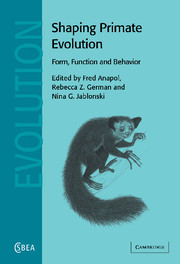Book contents
- Frontmatter
- Contents
- List of contributors
- Preface: shaping primate evolution
- 1 Charles Oxnard: an appreciation
- Part I Craniofacial form and variation
- Part II Organ structure, function, and behavior
- Part III In vivo organismal verification of functional models
- Part IV Theoretical models in evolutionary morphology
- Part V Primate diversity and evolution
- 16 The evolution of primate ecology: patterns of geography and phylogeny
- 17 Charles Oxnard and the aye-aye: morphometrics, cladistics, and two very special primates
- 18 From “mathematical dissection of anatomies” to morphometrics: a twenty-first-century appreciation of Charles Oxnard
- 19 Design, level, interface, and complexity: morphometric interpretation revisited
- 20 Postscript and acknowledgments
- Index
- References
19 - Design, level, interface, and complexity: morphometric interpretation revisited
Published online by Cambridge University Press: 10 August 2009
- Frontmatter
- Contents
- List of contributors
- Preface: shaping primate evolution
- 1 Charles Oxnard: an appreciation
- Part I Craniofacial form and variation
- Part II Organ structure, function, and behavior
- Part III In vivo organismal verification of functional models
- Part IV Theoretical models in evolutionary morphology
- Part V Primate diversity and evolution
- 16 The evolution of primate ecology: patterns of geography and phylogeny
- 17 Charles Oxnard and the aye-aye: morphometrics, cladistics, and two very special primates
- 18 From “mathematical dissection of anatomies” to morphometrics: a twenty-first-century appreciation of Charles Oxnard
- 19 Design, level, interface, and complexity: morphometric interpretation revisited
- 20 Postscript and acknowledgments
- Index
- References
Summary
Origins of morphometrics
The origin of morphometrics lies in the burst of methodological creativity that predates the availability of relevant datasets requiring such methods. A seminal decade saw developments from Hotelling (1931), Wilks (1935), Bartlett (1935), Fisher (1936), Mahalanobis (1936), and others. And the next 20 years provided the extensions of the methods by Rao (1948), Yates (1950), Kendall (1957), and others. Most of these investigations concentrated on developing the methods. The actual data examined during these developments were so few that, though they permitted analysis by manual techniques, they were too restricted to allow examination of real biological problems. One well-known dataset was Anderson's measurements of four variables, the lengths and breadths of sepals and petals, taken on 50 specimens each of three groups of iris. These data were used by Fisher (1936) in the development of the techniques, and by many other investigators since, including myself (e.g., Oxnard, 1973, 1983/84), both for development and for checking.
Of course, the antecedents of morphometrics came from even earlier times (e.g., Galton, 1889; Pearson, 1901) and even the nineteenth and late eighteenth centuries (e.g., Adanson, 1763; Quetelet, 1842). But it was not until the second half of the twentieth century that morphometric methods could be applied to large datasets (many variables, many specimens, many groups) and could be aimed at examining real rather than exemplar anthropological problems (e.g., Trevor, 1955; Ashton et al., 1957, 1975, 1976, 1981; Oxnard, 1967; Howells, 1973).
- Type
- Chapter
- Information
- Shaping Primate EvolutionForm, Function, and Behavior, pp. 391 - 414Publisher: Cambridge University PressPrint publication year: 2004



